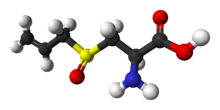


| |

| |
| Names | |
|---|---|
| Systematic IUPAC name
(2R)-2-Amino-3-[(S)-(prop-2-ene-1-sulfinyl)]propanoic acid | |
| Other names
3-(2-Propenylsulfinyl)alanine | |
| Identifiers | |
| |
3D model (JSmol) |
|
| ChEBI | |
| ChEMBL | |
| ChemSpider |
|
| ECHA InfoCard | 100.008.291 |
| EC Number |
|
| KEGG | |
PubChem CID |
|
| UNII | |
CompTox Dashboard (EPA) |
|
| |
| |
| Properties | |
| C6H11NO3S | |
| Molar mass | 177.22 g/mol |
| Appearance | White to off white crystalline powder |
| Melting point | 163–165 °C (325–329 °F) |
| Soluble | |
| Hazards | |
| GHS labelling: | |

| |
| Warning | |
| H315, H319, H335 | |
| P261, P264, P271, P280, P302+P352, P304+P340, P305+P351+P338, P312, P321, P332+P313, P337+P313, P362, P403+P233, P405, P501 | |
| NFPA 704 (fire diamond) | |
| Safety data sheet (SDS) | External MSDS |
Except where otherwise noted, data are given for materials in their standard state (at 25 °C [77 °F], 100 kPa). | |
Alliin /ˈæli.ɪn/ is a sulfoxide that is a natural constituent of fresh garlic.[1] It is a derivative of the amino acid cysteine. When fresh garlic is chopped or crushed, the enzyme alliinase converts alliin into allicin, which is responsible for the aroma of fresh garlic. Allicin and other thiosulfinates in garlic are unstable and form a number of other compounds, such as diallyl sulfide (DAS), diallyl disulfide (DADS) and diallyl trisulfide (DAT), dithiins and ajoene.[2] Garlic powder is not a source of alliin, nor is fresh garlic upon maceration, since the enzymatic conversion to allicin takes place in the order of seconds.
Alliin was the first natural product found to have both carbon- and sulfur-centered stereochemistry.[3]
The first reported synthesis, by Stoll and Seebeck in 1951,[4] begins the alkylation of L-cysteine with allyl bromide to form deoxyalliin. Oxidation of this sulfide with hydrogen peroxide gives both diastereomersofL-alliin, differing in the orientation of the oxygen atom on the sulfur stereocenter.

A newer route, reported by Koch and Keusgen in 1998,[5] allows stereospecific oxidation using conditions similar to the Sharpless asymmetric epoxidation. The chiral catalyst is produced from diethyl tartrate and titanium isopropoxide.
Garlic has been used since antiquity as a therapeutic remedy for conditions now associated with oxidative stress (production and accumulation of reactive oxygen species (ROS)). In an in vitro test (1991), garlic powder showed antioxidant properties, and alliin showed good hydroxyl radical-scavenging effect. [6] Alliin has also been found to affect immune responses in blood.[7]
{{cite book}}: |journal= ignored (help)